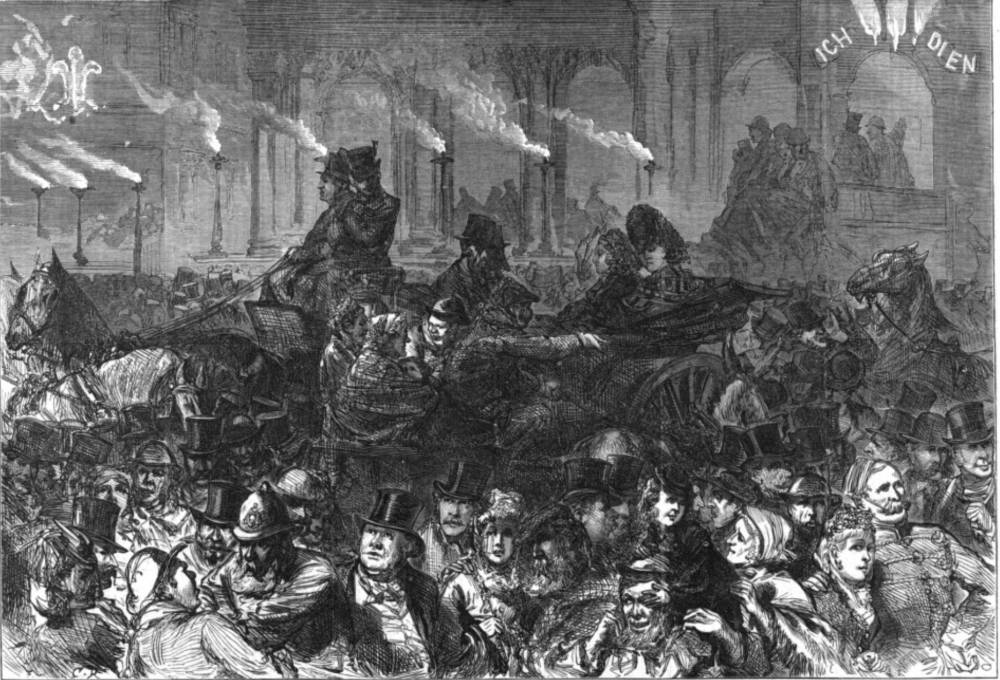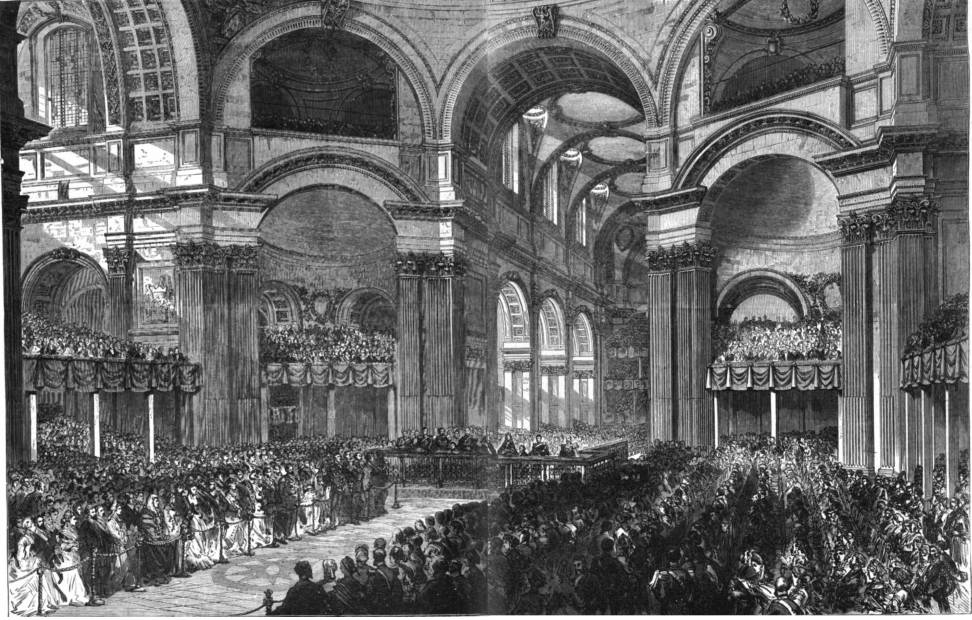After the recovery of the Prince of Wales from a severe illness in 1872, Queen Victoria proclaimed a day of thanksgiving; or, as The Illustrated London News put it, “The Queen of Great Britain and Ireland, on Tuesday last, went to St. Paul's Cathedral, in the city of London, with her son the Prince of Wales, to give public thanks to God for his recovery from the illness which had wellnigh cost his life.” As the periodical’s illustrations demonstrate, this Thanksgiving Day involved the kind of elaborate decorations and ceremony more familiar to the England of Shakespeare’s time than Victoria’s. The Illustrated London News took public’s enthusiastic reaction to the celebration to be “a most significant token of the real state of the country,” the most significant aspect of which was its “universal acceptance” of both Queen Victoria and government by a conctitutional monarchy:
It has been the happier destiny of Victoria to exemplify, in her reign, since 1837, the complete realisation of this desirable state of feeling. There is now a general recognition, in spite of all pedantic Republican theorists, of the great advantages, political, social, and moral, derived from a constitution and form of government that reserves the presidency of the nation for an hereditary proprietor, while separating this rank and title from the actual tenure of executive power. It is perceived that by this arrangement we are spared the mischievous effects of those intrigues on the part of influential nobles or ambitious leaders of faction to obtain the perpetual supremacy in the State for themselves individually, and for their descendants, which have so often proved fatal to the freedom of a nominal Commonwealth. The law of inheritance, which common experience has recommended for the security of our private welfare, is found equally conducive to the public good when applied to the office of Royalty. This seems to be the conclusion in which the practical English mind is content to rest. The perilous illness of the Queen's eldest son—of the heir to that throne whioh we trust she herself will long occupy—has very recently compelled us to take the lesson more seriously to heart.

Thanksgiving Day: The Triumphal Arch at Ludgate Circus. Click on image to enlarge it. 1869. Source: Illustrated London News.
“The streets were kept by a strong force of police and military, the traffic of carriages being stopped, and the roadway being cleared also of foot-passengers not furnished with tickets of permission. Bands of school-children sang hymns as the procession went by. The people everywhere hailed the approach of the Royal party with hearty and enthusiastic cheering. All eyes were bent on the last carriage to see the Queen, the Prince, and the Princess of Wales. Her Majesty looked in good health, and she looked happy. So did the Princess. As for the Prince, he looked pale, but not thin, after his illness; he seemed, however, to be in good spirits, and kept taking off his hat to bow to the people who cheered him. The Queen wore a corded black silk dress, trimmed with miniver, and a jacket to match. Her Majesty also wore a black bonnet, with black and white feathers and white flowers. The Princess wore a dress of dark blue satin, with polonaise of blue velvet, trimmed with fur, and a bonnet of blue velvet with feathers of the same colour. The Prince of Wales wore the uniform of a General offioer, with the collars of the Orders of the Garter and the Bath. The Duke of Edinburgh wore his naval uniform ; Prince Arthur wore that of the Rifle Brigade, and Prince Leopold wore the Highland costume.”


Left: The Great Stand at the site of the Law Courts. Right: Temple Bar decorated. [Click on images to enlarge them.]
“At Temple Bar the Queen was met by the Lord Mayor, the Sheriffs, and a deputation from the Aldermen and Common Council of the city of London, all in their robes, mounted on horseback. They all alighted, and the Lord Mayor delivered to and received back from her Majesty the City sword, according to the usual custom. But, contrary to general expectation, the gates of Temple Bar were not closed against the Queen, so that it was unnecessary to present her with the keys, and the heralds omitted to sound a flourish. The Lord Mayor, Sheriffs, and deputation again mounted their white horses, and preceded her Majesty on horseback to St. Paul’s, and cm arriving there proceeded to take the several places reserved for them in the cathedral. The Lord Chancellor and the Speaker likew ise, on arriving at the west entrance. proceeded to their seats.”


Left: Arrival at St. Paul's Cathedral. Right: The Illuminations. [Click on images to enlarge them.]
“The Queen, with the Prince of Wales on her right and the Princess of Wales on her left hand, but taking the Prince’s arm, walked up the nave, from the reception-rooms at the west door to the Royal pew, in a procession marshalled by the Lancaster and Somerset heralds, who led the way. It comprised the officers of the Lord Chamberlain’s department, the equerries in attendance, the great officers of the Royal household, and those of the Prince’s household, the Captains of the Royal Guard and Gentlemen-at-Arms, Garter King-at-Arms, and the other heralds, the Gold Stick and Silver Stick, the Master of the Horse, Lord Steward, Lord Chamberlain, and Vice-Chamberlain, who walked before the Queen. Behind her Majesty came the Duke of Edinburgh and Princess Beatrice, with the two boys, Prince Albert Victor and Prince George of Wales. Prince Arthur and Prince Leopold followed; then the Duke of Cambridge. The Mistress of the Robes, the Duchess of Sutherland, the Ladies of the Bedchamber, and the Chamberlain of her Royal Highness, brought up the rear of the procession.”

The Thanksgiving service in St. Paul’s Cathedral
“The service began with the ‘Te Deum,’ composed expressly for the occasion by Mr. Goss, and sung by a choir of 250 voices, selected from the best cathedral and chapel choirs in England. They were accompanied on the organ by Mr. Cooper, but the pedals were played separately by Mr. Willis, who built the new organ. Then followed a few responses from the Liturgy and the Lord’s Prayer, intoned by the Rev. J. H. Coward, the collect beginning “O God, the Protector of all that trust in Thee,” the ordinary’ prayers for the Queen and Royal family, and the general thanksgiving, in which was inserted this clause, “particularly to Albert Edward Prince of Wales, who desires now to offer up his praises and thanksgivings for Thy late mercies vouchsafed to him.” A solemn and significant pause was made at these words. The special form of thanksgiving was then read.”
You may use this image without prior permission for any scholarly or educational purpose as long as you (1) credit the Hathi Trust Digital Library and The University of Michigan Library and (2) link your document to this URL in a web document or cite the Victorian Web in a print one.
Bibliography
“The Thanksgiving Day.” Illustrated London News. (9 March 1872): 204-205, 213, 222. Hathi Trust Digital Library version of a copy in the University of Michigan Library. Web. 26 December 2015.
Last modified 26 December 2015